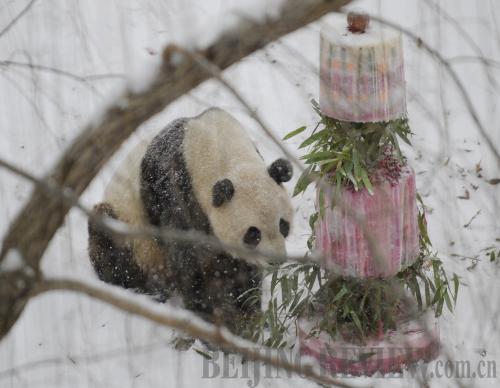|
 |
|
FAREWELL TREAT: Tai Shan eats a three-tiered bamboo-and-beet cake at a farewell party at the Smithsonian's National Zoo in Washington, D.C., where the panda bear was born (ZHANG JUN) |
More than 150 visitors braved heavy snow in Washington, D.C. for a final opportunity to see Tai Shan, the first surviving giant panda cub born at the National Zoo, before it departed for its new home in China. Though the farewell party specially held for the snuggly animal on January 30, 2010, ended earlier than expected due to inclement weather, America's deep fondness for Tai Shan was felt throughout the city.
The fuzzy, beloved star resident of the U.S. capital left on February 4, taking a cargo jet sponsored by FedEx back to China for a breeding program for the endangered species. His fellow traveler on the flight was three-year-old female panda Mei Lan from the Atlanta Zoo in Georgia. The journey to China left Washington's Dulles International Airport and took 14.5 hours on its non-stop route.
The zoo, which is part of the Smithsonian Institution, announced Tai Shan's departure under an agreement with China's Wildlife Conservation Association (CWCA) in December, 2009. "The Chinese have granted extensions (twice) to the National Zoo that allowed Tai Shan to stay for an additional two-and-a-half years, but those extensions have expired," the zoo said in a media advisory.
But for Tai Shan's fans who witnessed his birth and growth from a tiny, pink and hairless infant to a 4.5-year-old teenage bear weighing almost 200 pounds, sadness at the coming farewell increased as Tai Shan's days in the United States dwindled.
"Everyone is sad that he is leaving us, but happy that he is so important to panda conservation," said National Zoo Senior Curator Brandie Smith during an online meeting with panda lovers. "Tai Shan's genes are most valuable in China. This is a global program to save the species and his best mate matches are there."
Mr. Popular
Children shouted his name outside his compound and Tai Shan, who was busy napping, was curled up in an elevated spot. He kept his belly close to the ground to fight the cold after finishing a three-tiered bamboo-and-beet cake.
"Don't worry, his fur skin is thick enough to protect him against the snow," a man who brought his family to the farewell celebration whispered to his little daughter. "Say goodbye to Tai Shan!" he reminded her gently.
Adoring fans from all over the country took pictures, recorded him on video and watched him silently along the railing to his enclosure at the Giant Panda Habitat in the snow. Crowds filled souvenir shops searching for panda-themed mugs, T-shirts, plush toys and post cards.
The playful cub, nicknamed Butterstick because he could fit into the palm of a person's hand, has been a delight to millions of visitors and those who have watched him grow through an online webcam since his public debut in December 2005.
"He will be missed by Washingtonians," wrote a blogger named Rachel who has been watching him on the webcam over the years. "We love our pandas."
Tai Shan's parents, Mei Xiang and Tian Tian, were shipped to Washington from the CWCA on a 10-year loan in 2000. On July 9, 2005, Mei Xiang gave birth to a male cub that 200,000 people named Tai Shan through an online poll, which in Chinese means Taishan Mountian, one of the five sacred mountains in the country.
There has been a huge surge in attendance at the zoo ever since Tai Shan's public debut. In the first several months of his display, attendance jumped by as much as 50 percent over previous years. Officials estimated that Tai Shan has attracted more than 12,000 visitors to the zoo. The webcam, which broadcasts the cub's daily activities, has drawn an average of 1 million clicks every month.
| 